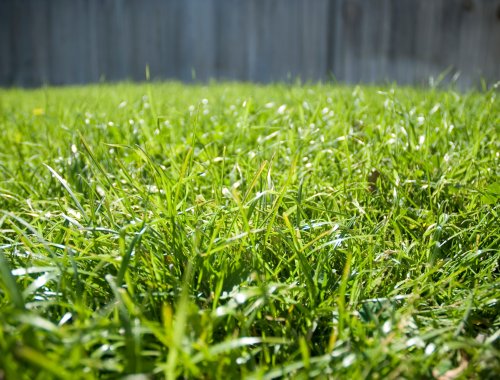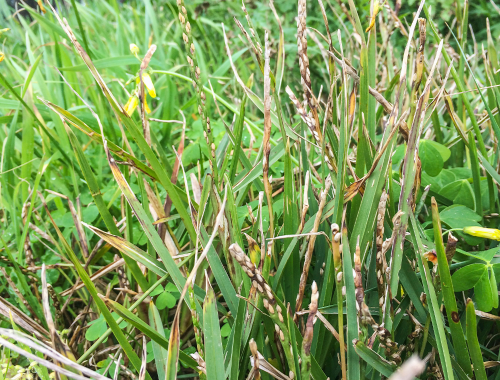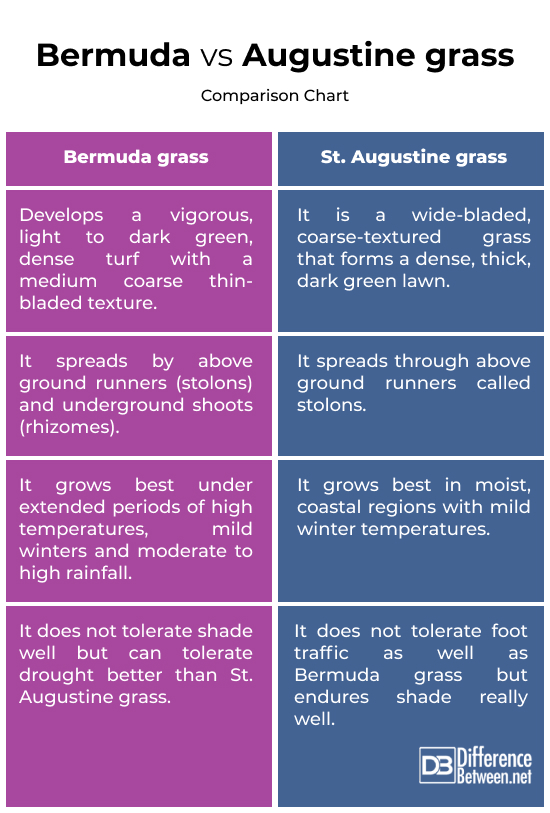Difference Between Bermuda and St. Augustine Grass
If you’re a homeowner trying to establish a new lush green lawn or renovate an existing one, it’s important to choose the right species. Selecting the right kind of turf grass is essential to a healthy green lawn. Typically turf grasses for lawns are either warm-season or cool-season. Bermuda and St. Augustine are the two most common warm-season species for lawns. In this article, we break down some key differences between the Bermuda and St. Augustine grass.

Bermuda grass
Bermuda grass is a common warm-season grass native to the southern region of the United States. It is a major turf species for lawns, parks, golf courses, sports fields, and commercial and public landscapes. It is a creeping grass that is highly tolerant to drought and when properly managed, develops into a dense turf. It is a sod-forming perennial species that spreads by stolons, seed and rhizomes. Stolons of the Bermuda grass readily root at the nodes. It grows best under extended periods of high temperatures and mild winters. Temperature limits its adaptability to tropical and subtropical regions of the world.

St. Augustine grass
St. Augustine is a low-maintenance, warm-season grass widely used for pastures and lawns. Also known as buffalo grass or buffalo turf, St. Augustine is thick, dark green grass native to the tropical regions, from the Carolinas to Florida and along the gulf coast to Texas and in southern and central California. One of the best things about the St. Augustine grass is its ability to endure shade better than any other lawn grass in the region to which it is adapted. It remains green but dormant throughout most winters in southern half of Texas.
Difference between Bermuda and St. Augustine grass
Characteristics
– Both Bermuda and St. Augustine grass are among the most common types of warm-season grass used primarily for lawns, golf courses, sports fields, and other commercial landscapes. Bermuda grass forms a vigorous, light to dark green, dense turf and it has a medium soft to medium coarse thin-bladed texture. St. Augustine is a wide-bladed, coarse-textured grass that forms a dense, thick, dark green lawn crowding out most weeds.
Adaptation
– Bermuda grass is popularly known for its aggressive growth and it spreads by above ground runners (stolons) and underground shoots (rhizomes). It grows best under extended periods of high temperatures, mild winters and moderate to high rainfall. St. Augustine, on the other hand, grows relatively slowly and spreads through above ground runners called stolons. It grows best in moist, coastal regions with mild winter temperatures.
Tolerance
– St. Augustine grass does not tolerate foot traffic as well as other warm season grasses such as Bermuda grass. It forms satisfactory turf with proper maintenance, effectively competes with weeds and other grasses. However, it endures shade better than any other lawn grass in the region to which it is adapted. Bermuda, on the other hand, does not tolerate shade well but it can tolerate drought better than any other turf grass. In addition, Bermuda grass requires less fertilizer and water than St. Augustine grass.
Mowing
– St. Augustine is a more forgiving species when it comes to mowing. It typically requires mowing once a week during the growing season, and it can be reduced to twice monthly during late fall. The mowing heights may range from 1 to 3 inches depending on the frequency of mowing and the presence of shade. Bermuda grass requires more maintenance in terms of mowing and requires frequent mowing and watering. To maintain good turf density, it is typically recommended to keep the tissue leaf under 40 percent at the time of mowing.
Bermuda vs. St. Augustine grass: Comparison Chart

Summary
While both Bermuda and St. Augustine are perennial warm-season species commonly used for lawns and sports fields, they have their fair share of differences in terms of characteristics, adaptation and growth, and maintenance needs. Bermuda grows best under extended periods of high temperatures and mild winters whereas St. Augustine grows best in moist, coastal regions with mild winter temperatures. St. Augustine is better shade resistant while Bermuda is better drought resistant.
How to tell the difference between Bermuda grass and Saint Augustine?
Bermuda forms a vigorous, light to dark green, dense turf and it has a medium soft to medium coarse thin-bladed texture whereas St. Augustine forms a dense, thick, dark green lawn with a wide-bladed, coarse-textured grass.
Which is more expensive Bermuda or St. Augustine grass?
Both are quite similar in terms of pricing, with costs ranging from $0.30 to $0.85 per square foot.
Can St. Augustine overtake Bermuda?
Under favorable growth conditions, St. Augustine may easily outgrow Bermuda and establish a dense, thick turf. It a lawn has a lot of shade, St. Augustine may grow more vigorously than Bermuda grass.
Can you mix Bermuda grass and St. Augustine grass?
Yes, you may be able to use Bermuda and St. Augustine together to fill in those weird patches of exposed soil on your lawn, and you get a fresh healthy lawn covered with vibrant greens.
What are the disadvantages of St. Augustine grass?
Some downsides of St. Augustine include lack of cold tolerance and foot traffic, susceptibility to diseases and insects, and so on.
What are the cons of Bermuda grass?
Cons of Bermuda grass include lack of shade tolerance, aggressive growth, poor tolerance to insects and diseases, and high dependence on tropical conditions.
- Difference Between Caucus and Primary - June 18, 2024
- Difference Between PPO and POS - May 30, 2024
- Difference Between RFID and NFC - May 28, 2024
Search DifferenceBetween.net :
Leave a Response
References :
[0]Welsh, Douglas F. Doug Welsh’s Texas Garden Almanac. Texas, United States: Texas A&M University Press, 2007. Print
[1]Aldous, David. International Turf Management. Oxfordshire, England: Routledge, 2014. Print
[2]Duble, Richard L. Turfgrasses: Their Management and Use in the Southern Zone, Second Edition. Texas, United States: Texas A&M University Press, 1996. Print
